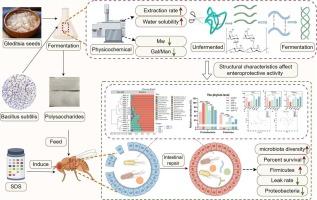Physicochemical characterization and enteroprotective activity of triple-helix Gleditsia seed polysaccharides prepared by the probiotic fermentation method
IF 9.8
1区 农林科学
Q1 CHEMISTRY, APPLIED
引用次数: 0
Abstract
To address the scarcity of natural plant-derived triple-helix polysaccharides, Gleditsia seed polysaccharides (GSPs) with intestinal benefits have been used as raw materials. Fermentation converts naturally disordered polysaccharide structures into triple helices. We applied the Drosophila intestinal inflammation model to assess polysaccharide activity. After 3-h fermentation with Bacillus subtilis, triple-helix GSPs were prepared. GSP-f exhibited a 31.83 % higher yield and a 1.66-fold improved solubility compared to GSP-u, with an optimized molecular weight (1.48 × 105 g/mol) and a 2: 1 mannose/galactose ratio. In Drosophila models, GSP-f showed 30.50 % enhanced intestinal epithelial protection, 13.17 % improved barrier repair, 19.97 % lifespan extension, and a 40.4 % elevated Firmicutes/Proteobacteria ratio compared with GSP-u. Correlation analysis revealed that the triple-helix structure was correlated with the Firmicutes abundance. Notably, GSP-f and GSP-f-2 exhibited equivalent bioactivity. The fermentation-produced triple-helix polysaccharides achieved optimal functionality without purification. These findings highlight the potential of probiotic fermentation for the efficient production of high-performance triple-helix polysaccharides.

益生菌发酵法制备皂荚三螺旋多糖的理化性质及肠道保护活性
为了解决天然植物来源的三螺旋多糖缺乏的问题,研究人员以对肠道有益的皂荚种子多糖(GSPs)为原料。发酵将自然无序的多糖结构转化为三螺旋结构。我们采用果蝇肠道炎症模型来评估多糖的活性。经枯草芽孢杆菌发酵3 h,制得三螺旋GSPs。与GSP-u相比,GSP-f的产率提高了31.83 %,溶解度提高了1.66倍,优化后的分子量为1.48 × 105 g/mol,甘露糖/半乳糖比为2:1。在果蝇模型中,与GSP-u相比,GSP-f增强了30.50% %的肠上皮保护,13.17 %的屏障修复,19.97 %的寿命延长,40.4 %的厚壁菌门/变形菌门比值升高。相关分析表明,三螺旋结构与厚壁菌门丰度相关。值得注意的是,GSP-f和GSP-f-2表现出相当的生物活性。发酵产生的三螺旋多糖无需纯化即可获得最佳功能。这些发现突出了益生菌发酵高效生产高性能三螺旋多糖的潜力。
本文章由计算机程序翻译,如有差异,请以英文原文为准。
求助全文
约1分钟内获得全文
求助全文
来源期刊

Food Chemistry
工程技术-食品科技
CiteScore
16.30
自引率
10.20%
发文量
3130
审稿时长
122 days
期刊介绍:
Food Chemistry publishes original research papers dealing with the advancement of the chemistry and biochemistry of foods or the analytical methods/ approach used. All papers should focus on the novelty of the research carried out.
 求助内容:
求助内容: 应助结果提醒方式:
应助结果提醒方式:


